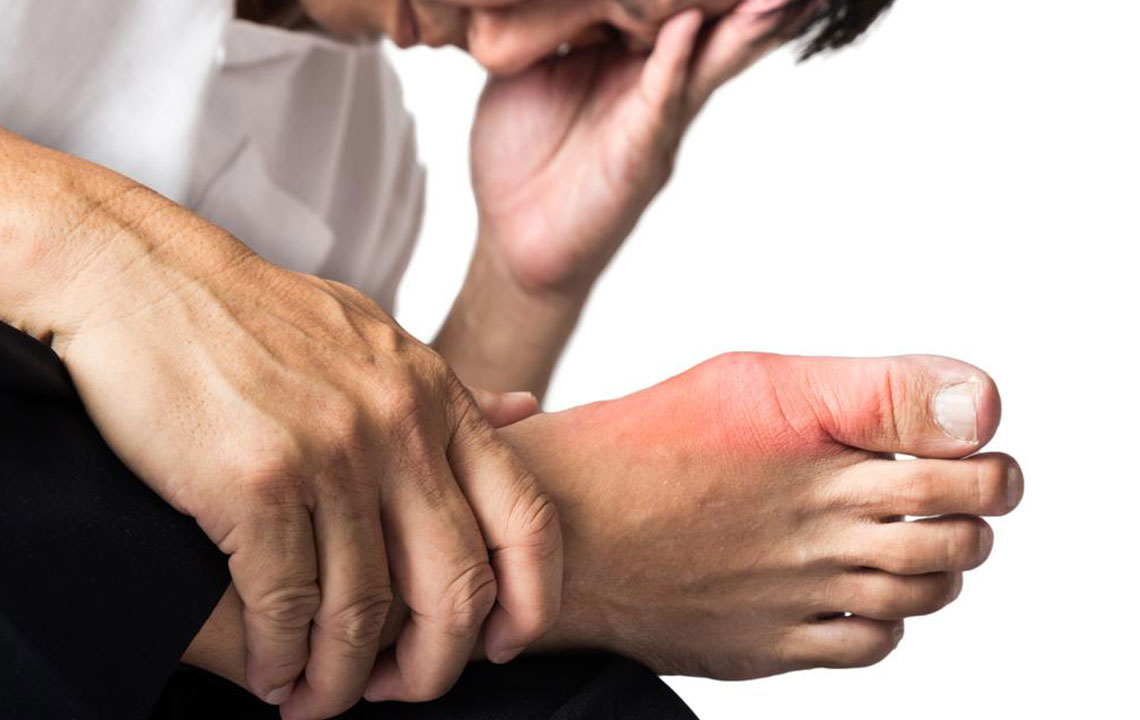Symptoms and Treatments for Gout
Gout is one of the most frequently recorded medical conditions over the past years and throughout the history.
A kind of arthritis, gout is caused when uric acid crystallizes in the body, and these crystals accumulate in joints. This happens when the body produces too much uric acid or fails to remove it, which results in increased levels of uric acid in the body. The uric acid crystals deposited in the joints cause an attack of sudden burning pain, stiffness or swelling (usually in the big toe). There are several cures for gout.
Symptoms of gout
The symptoms of gout include:

- Sudden increasing pain in the affected joint
- Heat in the afflicted area
- Joint swelling
- A reddish bruise or coloring on the skin
- Joint tenderness
These painful spells can last for hours, days, or sometimes weeks. Usually, this swelling or stiffness involves joints in the lower extremities, but severe gout can affect many joints at once. This is known as polyarticular gout. The painful attacks may frequently repeat, which can harm the joints, tendons and other muscle tissues in the afflicted area.
The presence of a tophus, a hard nodule of uric acid deposit under the skin, is another sign of gout.
Tophi indicates a substantial overload of uric acid levels in the body.
Cures for Gout
At the onset of gout, when the pain attacks are mild and infrequent, dietary and lifestyle changes must be made right away.
This can be an effective way to treat gout.
Guidelines to be followed are:
- Maintain high fluid intake – 2-4 liters a day
- Maintain a healthy body weight
- Eat a balanced diet – avoid fish, meat, and poultry
- Avoid alcohol
- But if the condition becomes severe, medications are necessary to lower the uric acid content.
There are three approaches to medicinal cures for gout.
First approach: Uric-acid (lowering) medications
This is the first line of cures for gout. The medicines used are aimed at decreasing the toxicity level of the absolute amount of uric acid in the bloodstream. The goal is to maintain it below 6 mg/dl. These medications work to decrease the size of tophus present in the body and eradicate its presence.
Urate-lowering medications include febuxostat (Uloric), pegloticase (Krystexxa), probenecid, and allopurinol (Zyloprim, Aloprim)
Second approach: Prophylactic Medications
Prophylaxis is the treatment given to prevent a disease. Prophylactic medicines are used in conjunction with medicines that lower uric acid, either to prevent flares of gout pain or to decline the frequent and severe pain attacks. These medicines are prescribed only for the first six months of the treatment as prophylactic medicines can also increase or decrease uric acid levels, and cause a gout attack. Medicines include nonsteroidal anti-inflammatory drugs such as indomethacin (Indocin, Indocin-SR), ibuprofen(Advil), diclofenac (Cataflam, Voltaren-XR, Cambia) or naproxen sodium (Aleve).
Third approach: Rescue medications
These medicines are only prescribed to be taken during acute gout attacks. They target the painful area and work towards decreasing the pain and inflammation. These rescue medications provide immediate relief. Corticosteroids such as prednisone, prednisolone (Orapred) and methylprednisolone (Medrol) can be used during an episode of an acute gout flare-up.
Home cures for Gout
It is recommended to see your doctor when symptoms of gout appear and follow the prescribed medication. There are few home remedies that can be helpful in curing gout.
Here are some of the home remedies that have had effective results:
· Apple cider vinegar – The vinegar helps your body become alkaline, and the acidity helps relieve the acute pain. It can also be used for topical treatment by soaking your foot in a mixture of 4 mugs of hot water and 1 cup of cider vinegar for 30 minutes. Or wrapping a soaked vinegar towel around the painful area for 15 minutes.
· Baking soda – A popular home remedy, baking soda works on the same lines as apple cider vinegar does. It makes your body alkaline. Consume ½ a spoon with a glass of water. The recommended dosage is four teaspoons throughout the day.
· Cherries – Cherries are known to lower uric acid levels as they are high in antioxidants. Also, the anthocyanin present in cherries helps reduce inflammation and related pain attacks. Eating 15 to 20 cherries a day should keep gout at bay.
· Ginger and turmeric – A most effective natural home remedy for pain is the use of ginger roots and turmeric powder. Chop off a piece and eat it raw or boil it to make ginger tea. Or take a teaspoon of turmeric with a glass of water.
· Lemon juice – High in vitamin C, lemon juice offers another way to bring down your uric acid levels. Drinking 3-4 glasses of lemon juice keeps the body alkaline throughout the day. You can even add half a teaspoon of baking soda for more effect.
Try implementing these cures for gout and get rid of the gout pain!

